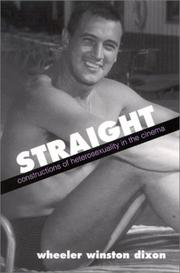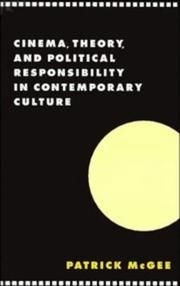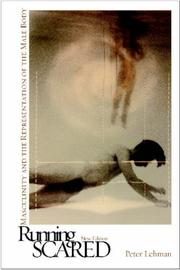| Listing 1 - 10 of 46 | << page >> |
Sort by
|
Book
ISBN: 0815652410 9780815652410 0815633327 9780815633327 Year: 2014 Publisher: Syracuse, New York : Syracuse University Press,
Abstract | Keywords | Export | Availability | Bookmark
 Loading...
Loading...Choose an application
- Reference Manager
- EndNote
- RefWorks (Direct export to RefWorks)
Imprisonment is a central trope of Irish nationalism, often deployed to portray the injustice of an Ireland occupied by foreign rule. Irish nationalism celebrates people jailed for resistance to British forces. While such a celebratory history resists colonialist images of Irish brutality, it also generates nationalist amnesia and nostalgia. Rethinking Occupied Ireland takes this history as its point of departure, arguing that the potent visual language generated to represent national heroes facilitates a narrow conceptualization of "occupation" and "resistance." Irish cinema has long offered a double critique-against both colonialist and nationalist historiography. Through a study of incarceration in film, Scarlata critiques state-of-emergency discourses and reveals the global relevance of Irish history to questions of terrorism, security, and sexual and gender transgression in an ever-lengthening list of crimes against the nation.The films included in this book, ranging from 1980 to 2010, explore Irish history from the perspective of those marginalized within or ejected from Irish and British national narratives, providing an ideal occasion to interrogate the legacy of colonialism and post/anticolonial nationalism. Examining Ireland's past in relation to its present, these films become a mode of postcolonial historiography, and, Scarlata argues, they are an important component in the reevaluation of what constitutes political cinema and political resistance.
Imprisonment in motion pictures. --- Sex role in motion pictures. --- Motion pictures
Book
ISBN: 3031128435 3031128443 Year: 2022 Publisher: Cham, Switzerland : Palgrave Macmillan,
Abstract | Keywords | Export | Availability | Bookmark
 Loading...
Loading...Choose an application
- Reference Manager
- EndNote
- RefWorks (Direct export to RefWorks)
Monsters in motion pictures. --- Sex role in motion pictures. --- Women in motion pictures. --- Motion pictures
Book
ISBN: 1441627081 9781441627087 1438428154 1438428111 9781438428116 9781438428123 143842812X 9781438428154 Year: 2009 Publisher: Albany, New York : State University of New York Press,
Abstract | Keywords | Export | Availability | Bookmark
 Loading...
Loading...Choose an application
- Reference Manager
- EndNote
- RefWorks (Direct export to RefWorks)
As celebrities sporting "baby bumps," politicians, Olympic athletes, and talk show guests, mothers are ubiquitous throughout U.S. media and popular culture. Like lightning rods, these high-profile mothers attract accolades and judgments associated with ideals of female sexuality, gender roles, and constructions of contemporary families. Motherhood Misconceived explores this widespread cultural fascination with motherhood through analyses of mothers in contemporary U.S. film, including both mainstream and independent cinematic representations. The contributors draw on a variety of critical approaches to consider the spectacle of pregnancy; mother-daughter relationships; mothers as predators, narcissists, and absent victims; and the ways in which cultural anxieties are displaced and projected onto marginalized mothers in films such as Fargo; Transamerica; Gas, Food, Lodging; Ordinary People; and Scream. Ideal for women's studies or film studies classes, Motherhood Misconceived will help students contextualize current debates about motherhood as they play out in popular and independent film.
Motherhood --- Motherhood in motion pictures. --- Sex role in motion pictures. --- Motherhood in motion pictures --- Sex role in motion pictures --- Sociology & Social History --- Family & Marriage --- Social Sciences --- Motion pictures --- Maternity --- Mothers --- Parenthood
Book
ISSN: 1458526X ISBN: 9517465440 9522227714 9522227706 9789522227713 9789522227706 9789517465441 Year: 2003 Volume: 7 Publisher: Helsinki: Finnish literature society,
Abstract | Keywords | Export | Availability | Bookmark
 Loading...
Loading...Choose an application
- Reference Manager
- EndNote
- RefWorks (Direct export to RefWorks)
"Films are integral to national imagination. Promotional publicity markets "domestic films" not only as entertaining, exciting, or moving, but also as topical and relevant in different ways. Reviewers assess new films with reference to other films and cultural products as well as social and political issues. Through such interpretive framings by contemporaries and later generations, popular cinema is embedded both in national imagination and endless intertextual and intermedial frameworks. Moreover, films themselves become signs to be cited and recycled as illustrations of cultural, social, and political history as well as national mentality. In the age of television, "old films" continue to live as history and memory. In Performative Histories, Foundational Fictions, Anu Koivunen analyzes the historicity as well as the intertextuality and intermediality of film reception by focusing on a cycle of Finnish family melodrama and its key role in thinking about gender, sexuality, nation, and history. Close-reading posters, advertisements, publicity-stills, trailers, review journalism, and critical commentary, she demonstrates how The Women of Niskavuori (1938 and 1958), Loviisa (1946), Heta Niskavuori (1952), Aarne Niskavuori (1954), Niskavuori Fights (1957), and Niskavuori (1984) have operated as sites for imagining "our agrarian past", our Heimat and heritage as well as "the strong Finnish woman" or "the weak man in crisis". Based on extensive empirical research, Koivunen argues that the Niskavuori films have mobilized readings in terms of history and memory, feminist nationalism and men's movement, left-wing allegories and right-wing morality as well as realism and melodrama. Through processes of citation, repetition, and re-cycling the films have acquired not only a heterogeneous and contradictory interpretive legacy, but also an affective force."
Book
ISBN: 1787698998 1787698971 178769898X 1787699005 9781787698970 9781787698994 9781787698987 Year: 2019 Publisher: Bingley, United Kingdom : Emerald Publishing Limited,
Abstract | Keywords | Export | Availability | Bookmark
 Loading...
Loading...Choose an application
- Reference Manager
- EndNote
- RefWorks (Direct export to RefWorks)
The horror genre will always remain current because it reflects our anxieties, shining a light onto our worst fears whilst creating worlds defined by darkness. Horror as a genre has always engaged with era-specific societal mores and moral panics, often about isolation or abandonment, changing family values and the role of women. It is often specifically about how gender is constructed in everyday life. Women are commonly defined in horror by their passivity, or monstrosity/sexuality or victimhood - or a mix of the three. At the same time women in horror are forced into psychological and physical torture ending in violent showdowns in which they emerge damaged but triumphant.Bringing together research from a wide range of established and emerging scholars this edited collection provides an insight into how modern horror films portray femininities, sexualities, masculinities, ageing, and other current issues, exploring the use of vampires, zombies, werewolves and ghosts in films made internationally. This volume, one of three by the same editorial team examining the horror genre, focuses on gender and contemporary horror in film, asking questions about how and if representations of gender in horror have changed. In these readings and re-readings, the authors examine developments in films about vampires, zombies, werewolves and ghosts, in films made internationally.
Horror films --- Sex role in motion pictures. --- History and criticism. --- Motion pictures --- Social Science --- TV & society. --- Gender Studies.

ISBN: 0791487334 1417524049 9781417524044 0791456234 9780791456231 0791456242 9780791456248 9780791487334 Year: 2003 Publisher: Albany : State University of New York Press,
Abstract | Keywords | Export | Availability | Bookmark
 Loading...
Loading...Choose an application
- Reference Manager
- EndNote
- RefWorks (Direct export to RefWorks)
straight / 'strāt (adj.) . . . without curves . . . correct . . . honest . . . not deviating from the normal . . . conventional . . . HeterosexualPractically all mainstream cinema is "straight," and has been since its inception. In Straight, Wheeler Winston Dixon explores how heterosexual performativity has been constructed in film, from early cinema to the present day. In addition to discussing how cinematic visions of masculine and feminine desire have been commodified and sold to reinforce existing societal constructs, Dixon also documents the recent emergence of "hypermasculinity," a kinetic and exaggerated masculinity that has been created to counter the more gentle, thoughtful male portrayed in While You Were Sleeping, Sleepless in Seattle, and other films that seemingly threaten the established order of patriarchal cinematic discourse.

ISBN: 0511582773 051100592X 9780511005923 0521581303 0521589088 9780511582776 9780521581301 9780521589086 Year: 1997 Volume: 24 Publisher: Cambridge : Cambridge University Press,
Abstract | Keywords | Export | Availability | Bookmark
 Loading...
Loading...Choose an application
- Reference Manager
- EndNote
- RefWorks (Direct export to RefWorks)
This 1997 book explores the political significance of aesthetic analysis in the context of cultural studies. It applies the theories of Adorno, Derrida, and Lacan to film studies, and asks how political responsibility can be reconciled with the concept of the university as a democratic institution. Art and the university, Patrick McGee claims, share a common feature: they are commonly regarded as autonomous realms that resist the determination of economic and political interests, while still playing a crucial role in ethical and political discourse. Through detailed reference to Neil Jordan's film The Crying Game, McGee shows how film can be both a product and a critique of the culture industry. He goes on to analyse the function of the university in producing interpretations of such highly political art forms and in determining the limits of critical discussion. McGee links Adorno with Derrida to provide a new route through cultural studies and the claims of political criticism.
Motion pictures --- Sex role in motion pictures. --- Culture in motion pictures. --- Aesthetics --- Philosophy. --- Aesthetics. --- Arts and Humanities --- Literature
Book
ISBN: 128203572X 9786612035722 1443804053 9781443804059 9781282035720 6612035722 Year: 2006 Publisher: Newcastle, UK : Cambridge Scholars Press,
Abstract | Keywords | Export | Availability | Bookmark
 Loading...
Loading...Choose an application
- Reference Manager
- EndNote
- RefWorks (Direct export to RefWorks)
Film and Sexual Politics: A Critical Reader features a variety of noteworthy critical essays that explore the evolution, representation, and social construction of sex, gender, and sexual orientation from the early days of cinema to the early twenty-first century. This collection investigates the complex relations between film form/style and sexual politics (past and present), as well as the ideological and social ramifications of those relations for the lived realities of individuals in th...
Sex in motion pictures. --- Sex role in motion pictures. --- Motion pictures --- Sex in moving-pictures --- Erotic films --- Pornographic films

ISBN: 081433556X 9780814335567 9780814333396 0814333397 Year: 2007 Publisher: Detroit : Wayne State University Press,
Abstract | Keywords | Export | Availability | Bookmark
 Loading...
Loading...Choose an application
- Reference Manager
- EndNote
- RefWorks (Direct export to RefWorks)
Book
ISBN: 1442275634 1442234474 9781442234475 1306637872 9781306637879 9781442234468 1442234466 9781442275638 Year: 2014 Publisher: Lanham, Maryland ; Plymouth, England : Rowman & Littlefield,
Abstract | Keywords | Export | Availability | Bookmark
 Loading...
Loading...Choose an application
- Reference Manager
- EndNote
- RefWorks (Direct export to RefWorks)
This companion volume to Reel Men at War takes a look at how women have been portrayed in war films, from silents of the 1920s to films of the 21st century. The authors explore the full range of women on the home front, covering nurses and doctors on the war front and women in combat. Films examined include Wings, A Farewell to Arms, Since Yo
War films --- Women in motion pictures. --- Sex role in motion pictures. --- Motion pictures --- History and criticism. --- War films History and criticism --- History and criticism
| Listing 1 - 10 of 46 | << page >> |
Sort by
|

 Search
Search Feedback
Feedback About UniCat
About UniCat  Help
Help News
News